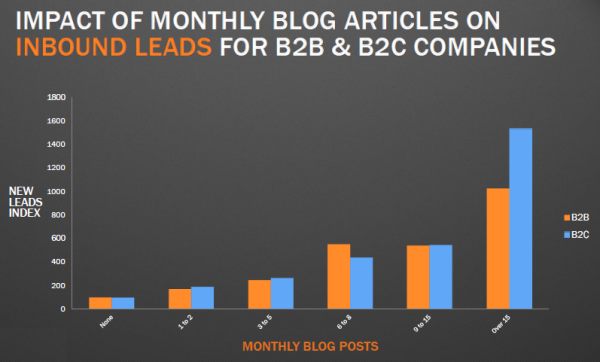This is a guest blog post by Michelle Nickolaisen
You’ve probably been told that blogging is a must-do for your business – after which you nodded, put it on the list of things to do, and moved on to something else. But did you know that small businesses with blogs generate 126% more leads than those without? (Source)
Today’s post addresses one of the most common problems business owners have with blogging: making the time from “just started blogging” to “actually getting customers and clients through my blog” as short as possible.
The key to a blog that actually sells your products and services? An editorial calendar.
What’s an editorial calendar?
First off, we’ll define “editorial calendar” so that we’re all on the same page here. (No pun intended.) An editorial calendar is simply a schedule of what’s being published and when. The term originates in the traditional publishing industry, but for the purposes of this post, “editorial calendar” means the schedule that covers:
- posts on your blog
- articles or posts places other than your blog that are part of your marketing strategy
- the social media updates that correspond with the above two types of posts
Why is an editorial calendar so important?
Step one: Create a marketing calendar
Creating an effective marketing calendar could be a whole post in and of itself, but a quick starter process for getting your own marketing calendar down is to:
- Map out the major product/service releases, updates, or launches that you know are coming over the next 6-12 months.
- Mark down any times of year that are busier than normal or slower than normal.
- Plan your marketing efforts based off of those two points. You’ll probably want to plan more marketing efforts (and thus content) around your product launches and slow periods, and lay off a little bit during your busier periods.
Step two: Blog consistently – and choose the right topics
Companies that blog six or more times a month have almost twice as many inbound leads as companies that blog five or less times a month. Businesses that blog 15 or more times a month almost double that again (for B2B companies) and nearly triple their inbound leads if they’re B2C companies. (Source)
Obviously that’s a lot of content – but don’t get overwhelmed. Blogging once a week, consistently, is enough to make your audience grow leaps and bounds. In fact, that’s all we’ve done at Spokal for over a year now, and in that time, we’ve tripled our website traffic. It’s better to blog once a week consistently than to blog twice a week some weeks and not at all on other weeks.
After you choose what days and times you’ll post articles, you need to work on topics for your posts. That way, you can start planning a few weeks ahead at a time and get a backlog of posts scheduled, which gives you padding in case you’re unable to write for a few days or weeks at a time.
When it comes to choosing topics, you need to be creating posts that are entertaining, informative, or actionable (and ideally, all three). Honing your writing craft (or hiring a writer, which could be a solid investment depending on how much time and ability you have to invest) will help, but you can also use these tricks to get inspiration for post ideas:
- Solve the problem before the problem. Your services/products solve a problem, right? By creating content that solves the problem that comes directly before they purchase your product, you draw in potential customers and move them along the path to buying your offerings. For example, a web designer could write a series of blog posts on refining your branding and setting up a website – after someone has an idea of the brand image they’re going for and has a website set up, they’re ready for a professional web design.
- Get topics from your customers and readers. You can ask for these via social channels or find them by participating in communities. Join Facebook groups, LinkedIn groups, and Google+ communities where your potential customers are active, and look to see what they’re posting about. You’ll find out what they’re struggling with, what they’re fascinated by, and best of all, you’ll see it in their own words, which is invaluable for creating headlines and blog posts that will draw them in.
- Look at previous successful posts. Use your analytics tools to see which of your past posts get the most traffic from search engines and were the most popular on social media. It’s not unusual for posts that do well on social to be different posts than those that do well on search engines, so make sure to check for both. Every previous successful post can be repurposed (turned into video or audio for audiences that prefer different mediums) or you can use those posts to create follow up posts that go more in depth on the topic or take a different angle. The resulting posts will have a higher chance of being successful, since they’re based off of previously successful posts.
Set aside an hour or so and brainstorm as many post topics as you can. This keeps you from sitting at your computer trying to decide what you want to write about and lets you pull similar posts together into a series or put topical posts near a product launch, for example.
Step three: Don’t just post on your site
Depending on what your business is and who you’re trying to reach, it may make sense to look at writing guest articles for other sites as a way to drive traffic back to your site. You’ll want to put a focus on creating high quality articles, following submission guidelines if there are any posted, and being polite when interacting with the site owner. Many site owners are deluged with spammy or low quality guest post requests and will dismiss your pitch if you don’t follow instructions.
When done right, guest posting can help kickstart your content marketing efforts, establish you and your business as an industry leader, and bring potential clients and customers your way. It’ll work even better if you build it into your editorial calendar and work at it regularly.
Step four: Be proactive with your social
When you have a standout piece of content, going the extra mile to get it shared can make a huge difference in your content marketing efforts. Instead of just tweeting it a few times and then waiting for others to retweet it, spend an hour or so researching high-profile figures that regularly curate content and reach out to them. A simple “@name We just published this post – thought it might be useful to your followers! [post title] [link]” can do wonders, especially if you have room to state succinctly why it would be interesting to their followers. For example, add in “it relates to your post published last week.” (Assuming it actually does relate to their post, of course!)
This isn’t something you’ll want to do every single time you post, but when used sparingly, it can be very effective at increasing the reach of an article and getting your business in front of new people.
Also, don’t only post on social when you have a new article to share. Be sure to retweet and share quality content that your audience will find useful on your channels. Set aside 15-30 minutes a day to engage with the people you’re following and answer questions in any communities or groups you’re in.
You can also have themed days to fill up your posting schedule. For example, every Monday you post an inspirational quote on Facebook and Instagram to start the week off on the right foot, on Wednesdays you pose a question to your Facebook and Twitter communities to get a discussion going, etc. Your regular engagement time and any weekly themed days you have need to go in your editorial calendar.
That’s it, you’re done!
This whole process shouldn’t take any more than a few hours to set up, and if you work on it consistently, you’ll start seeing results fairly quickly. Make sure to measure the outcome of your efforts so that you can keep honing your plan as you move along. This will let you improve the strategy (and thus, the output of said strategy) month after month.
Want to go more in depth? Here’s some further reading:
- The Complete Guide Of How Often To Post, Tweet + Facebook For Your Small Business
- The Practical Guide To Creating A Blogging Strategy That Actually Works
- How do I choose blog topics if I’m in a “boring” industry?

